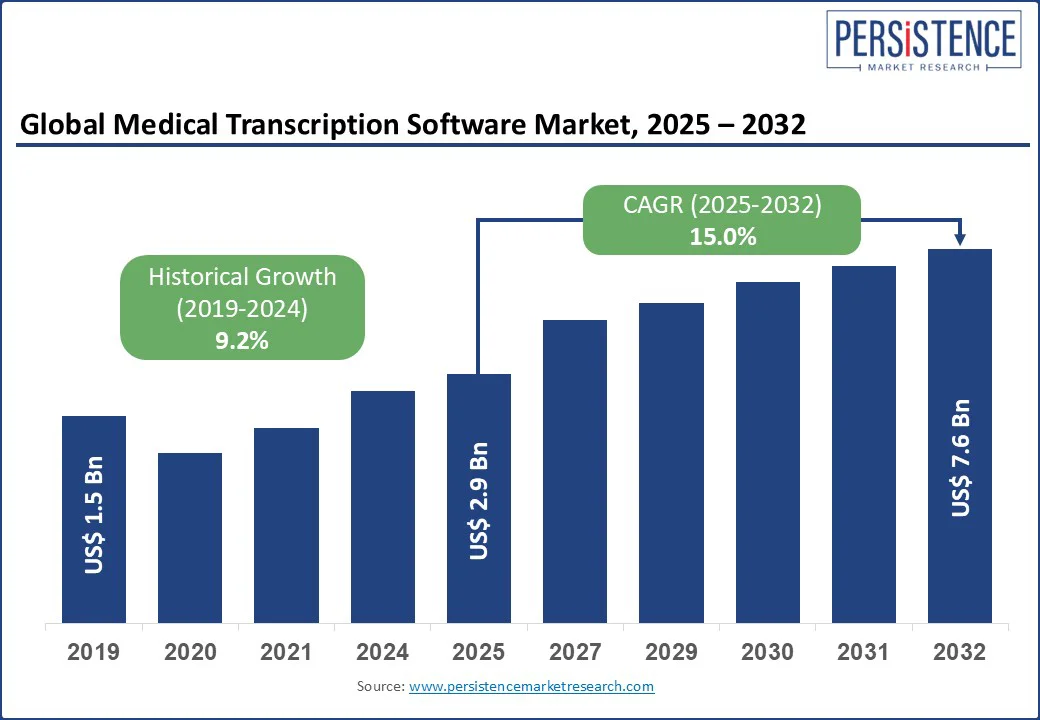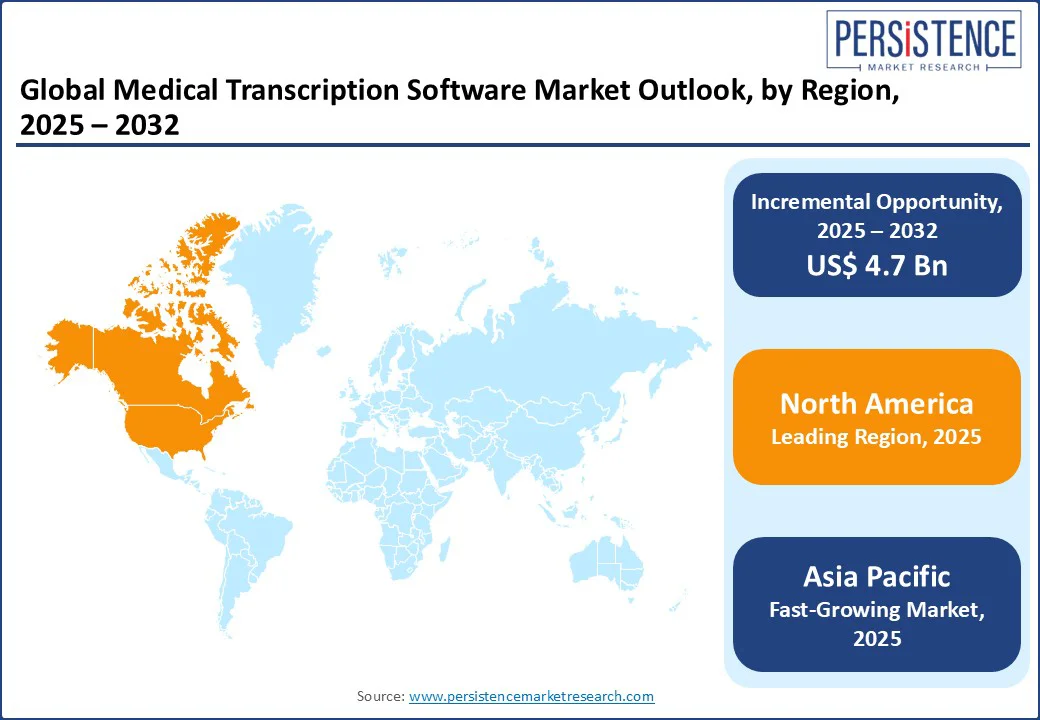ID: PMRREP34839| 189 Pages | 6 Aug 2025 | Format: PDF, Excel, PPT* | Healthcare

The global medical transcription software market size is likely to be valued at US$ 2.9 Bn in 2025 and is estimated to reach US$ 7.6 Bn in 2032, growing at a CAGR of 15.0% during the forecast period 2025 - 2032. The medical transcription software market growth is driven by the increasing demand for accurate clinical documentation, the rise in telemedicine adoption, and advancements in natural language processing (NLP) technologies. Key growth regions include North America and Asia Pacific, driven by healthcare digitization, regulatory mandates, and the growing need for real-time patient data access across hospitals and clinics.

Key Industry Highlights:
|
Market Attribute |
Key Insights |
|
Medical Transcription Software Market Size (2025E) |
US$ 2.9 Bn |
|
Market Value Forecast (2032F) |
US$ 7.6 Bn |
|
Projected Growth (CAGR 2025 to 2032) |
15.0% |
|
Historical Market Growth (CAGR 2019 to 2024) |
9.2% |
Accurate documentation is essential for patient safety, regulatory compliance, billing, and legal protection, as emphasized by the U.S. Department of Health and Human Services Office of Inspector General. A JAMA survey showed physicians using Electronic Health Records (EHRs) averaged 1.84 hours/day on documentation outside office hours versus 1.10 hours/day for non-EHR users.
Over 58.1% of doctors agreed that documentation reduces the time spent with patients, and 84.7% said that billing-related tasks increase workload. Electronic medical documentation burdens are linked to physician burnout. U.S. doctors spend nearly twice as long on clerical tasks compared to direct patient care, harming efficiency and satisfaction. Implementing medical transcription software significantly reduces documentation errors, improves turnaround, and frees physician time, directly addressing these challenges and driving market growth.
Data privacy and security concerns are a major restraint for the medical transcription software market, especially given the sensitive nature of patient health records handled by these platforms. In 2023 alone, the U.S. Department of Health and Human Services (HHS) Office for Civil Rights reported 725 healthcare data breaches, impacting over 133 million individuals, marking a record high. Several of these breaches directly involved transcription vendors. For instance, a significant breach at Perry Johnson & Associates compromised the data of around 9 million individuals, including 3.9 million patients from Northwell Health and 1.2 million from Cook County Health.
Hacking and IT-related incidents accounted for roughly 74%-79% of all large-scale healthcare breaches in 2022-2023, with business associates such as transcription vendors involved in about 35% of these cases. These incidents often lead to regulatory penalties, with the HHS OCR issuing more than US$ 136 Mn in civil monetary penalties in 2023 alone. As medical transcription platforms handle protected health information (PHI), any perceived or actual vulnerability, especially in cloud-based or AI-driven systems, can lead to significant legal, financial, and reputational risks. This has made many healthcare providers cautious about adopting such technologies, thereby restraining market growth.
Between January and March 2020, U.S. telehealth visits surged 154%, compared to the same period in 2019, with telemedicine encounters rising from roughly 1.08 million to 1.63 million visits in that quarter alone. By 2021, 37% of U.S. adults reported using telemedicine in the prior 12 months, while inpatient tele consults rose to about 46%, up dramatically from around 11% in 2019. Additionally, 76% of U.S. hospitals have implemented telemedicine programs, and 90% of healthcare organizations are either using or planning to invest in telehealth solutions.
Telehealth’s expansion, especially in remote, rural, and underserved areas, creates a strong demand for real-time transcription tools to capture virtual consults, ensure accurate documentation, and streamline clinical workflows. As telemedicine becomes a routine mode of care delivery, medical transcription software stands to play a pivotal role in enabling seamless documentation, regulatory compliance, and better patient-provider communication.
Voice recognition leads the market with approximately 60% share, primarily as it significantly improves the speed, accuracy, and efficiency of clinical documentation. Traditional manual transcription is time-consuming and often subject to human errors, whereas modern voice recognition tools powered by AI and natural language processing (NLP) can convert speech into text in real time with up to 95% accuracy. According to the National Institutes of Health (NIH), hospitals using speech recognition tools saw up to an 81% reduction in transcription costs and improved electronic documentation rates from 20% to 77%.
In addition, the widespread adoption of Electronic Health Records (EHRs) in regions such as North America, where over 90% of hospitals have adopted certified EHR systems, has driven the need for seamless, voice-enabled documentation solutions. Clinicians prefer voice-based systems as they allow hands-free operation, reduce administrative burden, and accelerate patient record updates without interrupting clinical workflows. The rise of telemedicine and virtual care models has also contributed to a surge in demand for voice recognition, as these tools help capture consultations instantly and improve care continuity. Overall, the combination of cost savings, high accuracy, regulatory-driven EHR adoption, and growing clinician acceptance makes voice recognition the leading technology in the market.
Cloud-based deployment is expected to lead the market with approximately 57% market share in 2025 for its scalability, cost-efficiency, and remote accessibility for healthcare compared to on-premise models. Healthcare providers, especially small to mid-sized clinics, prefer cloud platforms as they reduce IT infrastructure costs and allow remote access to patient records and transcription files, which is essential in the era of telemedicine and multi-location care teams.
Cloud systems also simplify software updates, data backups, and cybersecurity compliance, all managed by the vendor, thereby easing the burden on healthcare IT teams. In contrast, on-premise deployments demand significant upfront capital, physical server space, and dedicated IT staff for maintenance and upgrades. This makes them less attractive, especially for non-enterprise users. The cloud deployment is driven by flexibility, ease of integration, and lower total cost of ownership and continues to propel the segment growth.

North America is anticipated to account for the largest market share of 35% in 2025, due to its advanced healthcare infrastructure, widespread EHR adoption, strong regulatory frameworks, and high healthcare IT spending. The U.S. alone spent over US$ 4.5 Tn on healthcare in 2022, with a significant portion allocated to digital transformation. Additionally, rising physician burnout and demand for accurate, time-saving documentation tools have accelerated the shift toward voice-based transcription. The Health Information Technology for Economic and Clinical Health (HITECH) Act also played a major role by promoting EHR use, boosting the demand for integrated transcription solutions. Strong presence of key players further fuels the dominance of North America.
Europe is one of the leading regions in the medical transcription software market due to strong regulatory support, widespread electronic health record (EHR) adoption, and a growing focus on clinical documentation efficiency. The European Union’s General Data Protection Regulation (GDPR) has pushed healthcare providers to adopt secure and compliant transcription technologies, boosting demand for advanced software platforms.
Countries such as Germany and the U.K. have heavily invested in digital health infrastructure. Germany’s “Hospital Future Act” allocated €4.3 Bn (US$ 4.70 Bn ) for hospital digitization, including speech recognition and transcription systems. Additionally, the rising number of elderly patients and multilingual populations across Europe necessitates accurate documentation, where AI-powered voice recognition tools help reduce manual workload. Europe's mature healthcare systems, combined with language support for major EU languages, further solidify its leadership in the market.

The global medical transcription software market is moderately fragmented, with a mix of established tech giants and specialized healthcare IT vendors competing to provide advanced, compliant, and user-friendly solutions. Key players such as 3M Company, Microsoft Corporation, and Amazon Web Services (AWS) have leveraged their AI, cloud, and voice recognition technologies to build powerful transcription platforms that integrate seamlessly with Electronic Health Records (EHRs). Meanwhile, niche companies such as Aquity Solutions, SMARTMD, DeepScribe, and ZyDoc focus on healthcare-specific workflows, offering tailored features including HIPAA compliance, specialty-specific vocabularies, and automated editing tools.
The medical transcription software market is projected to be valued at US$ 2.9 Bn in 2025.
Rising demand for accurate clinical documentation and AI integration drives the medical transcription software market.
The medical transcription software market is poised to witness a CAGR of 15.0% between 2025 and 2032.
Expanding telemedicine, AI innovation, multilingual support, and mobile access create major transcription software opportunities.
Major players include Amazon Inc., Aquity Solutions, ZyDoc Medical Transcription, iMedX, Global Medical Transcription, and Microsoft Corporation (Dragon Medical One - DMO.
|
Report Attribute |
Details |
|
Historical Data/Actuals |
2019 - 2024 |
|
Forecast Period |
2025 - 2032 |
|
Market Analysis |
Value: US$ Bn |
|
Geographical Coverage |
|
|
Segmental Coverage |
|
|
Competitive Analysis |
|
|
Report Highlights |
|
|
Customization and Pricing |
Available upon request |
By Transcription Method
By Deployment
By End-use
By Region
Delivery Timelines
For more information on this report and its delivery timelines please get in touch with our sales team.
About Author